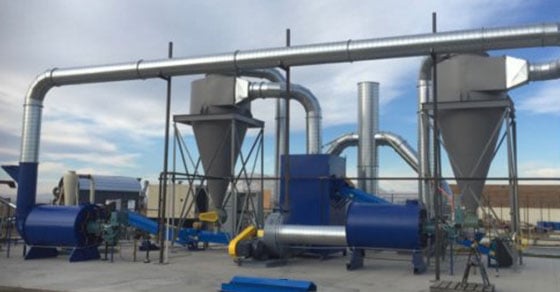Fluid bed dryers offer a number of advantages that make them the preferred approach to drying in a wide range of settings. What follows are some of the most frequently asked questions (FAQs) we receive as a fluid bed dryer manufacturer.
How does a fluid bed dryer work?
A fluid bed dryer works by pneumatically suspending solid particles in a gas stream. This design promotes maximum gas-to-solids contact.
The dryer consists of a stationary vessel, at the bottom of which is a perforated plate through which air is passed at the velocity needed to achieve minimum fluidization of the solids (not exceeding terminal velocity).
It’s important to note that variations on traditional fluid bed dryers, such as vibratory fluid beds, while based in fluid bed technology, are not true fluid beds, due to their employment of mechanical assistance to move particles through the unit.
What are the advantages of the fluid bed dryer design?
Fluid bed dryers offer high thermal efficiency, a small footprint, and minimal maintenance requirements. They are also generally more cost-effective compared to other industrial drying systems.
What are the disadvantages of the fluid bed dryer design?
The disadvantages to fluid bed dryers typically lie in their requirement for a highly uniform feedstock, an inability to garner energy savings when running at reduced capacities, and the need for a more robust exhaust gas system.
What materials can fluid bed dryers work with?
Fluid bed dryers are capable of processing a variety of materials. They are widely used in drying minerals, chemicals, metals, and biomass-derived feeds.
Materials with a large particle size, typically larger than ½ – 1”, are typically better suited to a rotary dryer. This is also the case with materials that exhibit variation in feed characteristics.
What is the retention time for a fluid bed dryer?
Retention time in a fluid bed dryer can vary significantly depending on the application and functional design. In general, however, five to 15 minutes is not uncommon.
How do I know if a fluid bed dryer is right for my process?
While fluid bed dryers can be used to process a wide range of materials, they generally work best for materials that are consistent in particle size and density.
FEECO also offers fluid bed dryer testing in our Innovation Center to help producers evaluate fluid bed technology in meeting their specific process and product goals, as well as establish data critical for scale-up and equipment design.
What capacities can fluid bed dryers handle?
Fluid bed dryers can range in size from modest pilot-scale units to massive systems processing in excess of 100 TPH.
What can I expect in terms of maintenance requirements?
Maintenance requirements for fluid bed dryers are minimal due to the lack of moving parts. The primary maintenance associated with fluid beds is related to the ancillary equipment such as fans and combustion systems.
Fluid bed dryers processing abrasive materials such as sand may also require additional maintenance of the unit itself to address abrasive wear.
What data is needed to design a fluid bed dryer?
As with the design of any industrial drying system, the manufacturer will require several points of data around the raw material and process objectives. This includes:
- Starting feed moisture content
- Desired outlet moisture content
- Maximum material temperature
- Chemical composition
- Particle size distribution
- Rheological properties (i.e., particle shape, is the material sticky, etc.)
- Desired throughput
- Bulk density
- Specific heat
Can fluid beds be automated?
Fluid bed dryers boast a high potential for automation capabilities, even making the need for operator intervention minimal. This includes the ability to incorporate features such as incremental starts and stops.
What parameters do fluid bed dryers use to influence the drying process?
Several process variables can be modified during the design process to meet process and product objectives. Among them:
- Air flow velocity (and subsequent fluidization regime)
- Bed distributor plate configuration
- Percent fill
- Feed & product flow rates
- System pressure
- Residence (retention) time
- Temperature profile
- Additional modifications to the dryer configuration
What’s the difference between a regular and vibratory fluid bed?
A true fluid bed dryer relies on pneumatic suspension to move material through the unit. In contrast, a vibratory fluid bed incorporates mechanical action (in this case, an oscillating thrust) to move the solids.
Vibratory fluid beds can be a good choice when working with less flowable materials. However, this also translates to a lower internal drying air flow and inherently larger machine. While the vibration helps to move material through the unit more quickly, it does not allow for true suspension (and therefore maximum gas-to-solids contact) to be achieved. The added vibration can also contribute to attrition.
What other equipment is necessary to support the fluid bed?
Fluid bed dryers require several pieces of ancillary equipment to function properly and within regulatory requirements:
- A furnace or hot air generator
- A fluidization blower
- An induced draft fan
- An exhaust air cleaning device such as a baghouse, cyclone or wet scrubber
- Feed and product takeaway conveyors
However, this equipment can typically be sourced as a complete system when working with an experienced and reputable manufacturer.
Are fluid beds batch or continuous?
Most fluid bed dryers are continuously operated, though some specialty applications, such as in the pharmaceutical sector, may merit a batch unit.
What temperatures do fluid bed dryers operate at?
Fluid bed dryers typically operate with inlet gas temperatures between 300°F to 1500°F, and exhaust gas temperatures around 170°F – 250°F.
Does mixing of solids occur in a fluid bed?
Yes, fluid bed dryers are considered a type of continuously stirred tank reactor (CSTR), because solids are well mixed. In cases where additional mixing is required, an agitator can be incorporated.
Which is better: a rotary dryer or fluid bed dryer?
When evaluating industrial drying systems, the choice often comes down to a fluid bed or rotary dryer. And while there is some overlap in their capabilities, these systems offer distinct advantages and disadvantages that can make them preferable in one setting over another.
Rotary dryers are typically best for high-capacity, heavy-duty settings, while fluid bed dryers offer a smaller, more cost-effective approach when solids are highly uniform.
Conclusion
Fluid bed dryers offer a cost-effective approach to drying bulk solids. FEECO recommends working with an expert to design a fluid bed dryer that will not only meet process and product goals, but that will also be reliable for years to come.
FEECO is a leader in industrial thermal processing equipment. In addition to fluid bed dryers, we manufacture custom rotary dryers, kilns, and coolers, with testing in our extensive R&D facility available. For more information, contact us today!



